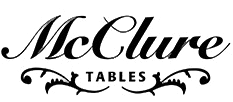Buying Guide History
History Of Shuffleboard Table Thickness
Did you know most tables advertised as 3" thick play boards are not? More than 90 percent of shuffleboard tables made all use 1/4" of a bar top epoxy for the finish. Mainly because it is easier and does not require the precision machining and preparation work on the butcher block surface. You also can get away with using soft maple, beech or other less expensive woods than Hard Maple and easier to work with and glue up. If you are going to cover your wood work with a plastic why bother using a premium wood or have state of the art German planning and sanding machines to prepare the surface? You just going to dam it up and pour a self leveling plastic over the top.
The old fashioned and a few small craft shops who understand the history behind a plastic poured epoxy finish and a traditional butcher block surface still maintain the heritage of making tables the same way they always did. The real purpose of the thick top as this video explains is so the shuffleboard surface can be repaired and maintained 30, 40 even 70 years in the future. We restore old boards made in the late 40's all the time. The poured plastic polymer came out in the 1970's we will not run the plastic polymer boards through our carbide planning knifes made in Germany. A new set of knifes cost about $5000 and we just do not restore or repair polymer poured boards. They are disposable something that sounds good makes a good selling pitch but the reality is the boards are not guaranteed to hold up in commercial environments and they can not be repaired. First after you took of the plastic you would be down to a 2 3/4" thick play-board. That would be two surface refinish repair jobs on a traditional board done the old fashioned way. We typically only take off 1/16" to 1/8" inch of wood to rejuvenate and bring and old 40 to 70 year old board back to it's original condition.

